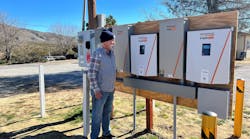San Diego Gas & Electric Tests Virtual Power Plant In Shelter Valley
San Diego Gas & Electric is experimenting on a new clean technology innovation named as a virtual power plant (a VPP) to reduce energy demand and put electricity back on the grid during peak hours through controlled customer-owned smart thermostats, rooftop solar, energy storage and other connected resources such as water pumps, as the region enters a heat wave and the power grid becomes strained.
The pilot located in Shelter Valley, eastern San Diego County, features participants like single-family homes with existing rooftop solar and the Shelter Valley Community Center, which was installed with two batteries onsite for free. The pilot, introduced in December 2022 and to run through December 2023, has been tested through 17 simulated demand response events.
To meet grid requirements, a VPP uses advanced software to aggregate and coordinate the functions of a collection of small-scale, decentralized resources located at customers' homes and businesses.
Software programs help VPPs function with grid operations to dispatch communications signals to devices in the VPP network to either power down or discharge electricity from existing resources back to the grid.
"The beauty of a virtual power plant is it can leverage existing resources to provide significant grid reliability benefits – with zero incremental emissions," said SDG&E Chief Commercial Officer Miguel Romero. "When hundreds or thousands of businesses or homes are connected to a VPP and their resources are flexibly managed to charge or discharge electrons, they can help keep the lights on during hot summer days."
SDG&E has already deployed its VPP pilot three times to support the grid during peak demand periods and connected devices functioned smoothly. Basis the performance, the company plans to expand the program to other areas in the future.
SDG&E's VPP involves smart thermostats, well water controllers and battery energy storage systems integrated into a centralized system as compared to a typical VPP involving only battery energy storage.
"We can use this equipment to maintain a place for people if the power goes off and keep the center cool and hope we can provide food if needed for our community residents," said Shelter Valley Community Center Board President Steve Bassett, who believes the project will better prepare the community for emergencies.
VPP participants can opt out for certain devices (except battery storage) upon receiving a message about the potential for their devices to be turned off or discharge electricity to support the grid. The opt-out rate is reported to be very low until now.


